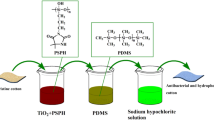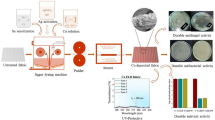Abstract
Recent years have witnessed the explosive progress of functional materials, which are made by loading various metal oxides onto fabrics. A cost-effective, facile, and simple approach of loading hexagonal zinc oxide (ZnO) sheets onto fabrics is highly desired. Here, the fabrication of the multifunctional ZnO@cotton fabrics is demonstrated using a surface micro-dissolution method by sodium hydroxide/urea (NaOH/urea) and zinc chloride (ZnCl2) aqueous solution. The hexagonal sheet ZnO forms the reflective layer to ultraviolet and near-infrared rays. The UV reflectivity of ZnO@cotton fabric is higher than the raw fabric in the range of 10.9–18.8% and UPF value of treated fabric was 100 + . Infrared barrier results were obtained through the phenomenon of heat radiation transfer obstruction, when fabrics being placed on the hot plate of 120 °C, the temperature difference between raw and treated fabrics is 6.6 °C. Also, the high antibacterial activity against Escherichia coli and Staphylococcus aureus cultures of ZnO@cotton fabric was testified.
Graphic abstract





Similar content being viewed by others

References
Abidi N (2012) Super-hydrophobic cotton fabric prepared using nanoparticles and molecular vapor deposition methods. ACS Symp 1107:149–165
Ang L, Zhang L (2007) Advance in solvents of cellulose. Acta Polym Sin 007:937–944
Arputharaj A, Nadanathangam V, Shukla SR (2017) A simple and efficient protocol to develop durable multifunctional property to cellulosic materials using in situ generated nano-ZnO. Cellulose 24:1–12
Ching CG, Lee SC, Ng SS et al (2013) Infrared reflectance studies of hillock-like porous zinc oxide thin films. Thin Solid Films 539:70–74
El-Naggar ME, Hassabo AG, Mohamed AL, Shaheen TI (2017) Surface modification of SiO2 coated ZnO nanoparticles for multifunctional cotton fabrics. J Colloid Interface Sci 498:413–422
El-Nahhal IM, Elmanama AA, El Ashgar NM et al (2017) Stabilization of nano-structured ZnO particles onto the surface of cotton fibers using different surfactants and their antimicrobial activity. Ultrason Sonochem 38:478
Fan T, Qian Q, Hou Z et al (2018) Preparation of smart and reversible wettability cellulose fabrics for oil/water separation using a facile and economical method. Carbohydr Polym 200:63–71. https://doi.org/10.1016/j.carbpol.2018.07.040
French AD (2014) Idealized powder diffraction patterns for cellulose polymorphs. Cellulose 21:885–896
Hu R, Zhao Z, Jing Z et al (2017) Surface micro-dissolution of ramie fabrics with NaOH/urea to eliminate hairiness. Cellulose 24:5251–5259
Hu R, Zhao Z, Zhou J et al (2019) Ultrasound assisted surface micro-dissolution to embed nano TiO2 on cotton fabrics in ZnCl2 aqueous solution. Ultrason Sonochem 56:160–166. https://doi.org/10.1016/j.ultsonch.2019.04.006
Hvam JM (1971) Temperature-induced wavelength shift of electron-beam-pumped lasers from CdSe, CdS, and ZnO. Phys Rev B 4:4459–4464
Kiomarsipour N, Razavi RS (2014) Hydrothermal synthesis of ZnO nanopigments with high UV absorption and vis/NIR reflectance. Ceram Int 40:11261–11268
Lee YJ, Ruby DS, Peters DW et al (2008) ZnO nanostructures as efficient antireflection layers in solar cells. Nano Lett 8:1501–1505
Lei C, Lou Q, Wang Z (2005) Study on stimulated emission from ZnO nanoparticle. Proc SPIE 6020:60201–60207
Li Y, Zou Y et al (2013) Investigation of antibacterial properties of nano-ZnO assembled cotton fibers. Fibers Polym 14:990–995
Li L, Fan T, Hu R et al (2017) Surface micro-dissolution process for embedding carbon nanotubes on cotton fabric as a conductive textile. Cellulose 24:1121–1128
Liu W, Liu S, Liu T et al (2019) Eco-friendly post-consumer cotton waste recycling for regenerated cellulose fibers. Carbohydr Polym 206:141–148. https://doi.org/10.1016/j.carbpol.2018.10.046
Look DC (2001) Recent advances in ZnO materials and devices. Mater Sci Eng B 80:383–387
Lu D, Qiang G, Wu X, Fan Y (2017) ZnO nanostructures decorated hollow glass microspheres as near infrared reflective pigment. Ceram Int 43:S0272884217306776
Lu M, Hu R, Zhao Z et al (2018) Surface micro-dissolve treatment of cotton fabrics with sodium hydroxide/urea to impart crease-resistance properties. Text Res J 88:1671–1676. https://doi.org/10.1177/0040517517708534
Okuhara Y, Kato T, Matsubara H et al (2011) Near-infrared reflection from periodically aluminium-doped zinc oxide thin films. Thin Solid Films 519:2280–2286
Petkova P, Francesko A, Perelshtein I et al (2016) Simultaneous sonochemical-enzymatic coating of medical textiles with antibacterial ZnO nanoparticles. Ultrason Sonochem 29:244–250
Pung SY, Choy KL, Vinogradov EA et al (2010) Structural and infrared properties of zinc oxide film and nanowires. J Cryst Growth 312:2220–2225
Ran L, Wang S, Lu A, Zhang L (2015) Dissolution of cellulose from different sources in an NaOH/urea aqueous system at low temperature. Cellulose 22:339–349
Salat M, Petkova P, Hoyo J et al (2018) Durable antimicrobial cotton textiles coated sonochemically with ZnO nanoparticles embedded in an in-situ enzymatically generated bioadhesive. Carbohydr Polym 189:198
Sen S, Losey BP, Gordon EE et al (2016) Ionic liquid character of zinc chloride hydrates define solvent characteristics that afford solubility of cellulose. J Phys Chem B 120:1134
Sricharussin W, Threepopnatkul P (2011) Effect of various shapes of zinc oxide nanoparticles on cotton fabric for UV-blocking and anti-bacterial properties. Fibers Polym 12:1037–1041
Tang Q, Gao LL, Yu B, Cong HL (2017) Fabrication of core-shell TiO2@SiO2 composites and investigation on its photocatalytic performance of methyl orange from aqueous solution. Integr Ferroelectr 179:159–165
Tao F, Hu R, Zhao Z et al (2016) Surface micro-dissolve method of imparting self-cleaning property to cotton fabrics in NaOH/urea aqueous solution. Appl Surf Sci 400:524–529
Tao F, Zhao Z, Jing Z et al (2018) Fabrication of magnetic cotton fabrics using surface micro-dissolving technology in ZnCl2 aqueous solution. Cellulose 25:1437–1447
Thennarasu G, Sivasamy A (2016) Enhanced visible photocatalytic activity of cotton ball like nano structured Cu doped ZnO for the degradation of organic pollutant. Ecotoxicol Environ Saf 134:412–420
Thi VHT, Lee BK, Ngo CV (2017) Durable superhydrophobic cotton filter prepared at low temperature for highly efficient hexane and water separation. J Taiwan Inst Chem Eng 71:527–536
Tomšič B, Jovanovski V, Orel B et al (2015) Bacteriostatic photocatalytic properties of cotton modified with TiO2 and TiO2/aminopropyltriethoxysilane. Cellulose 22:3441–3463
Xiong J, Zhao XF (2010) Solubility of cellulose in ZnCl2 aqueous solution and structure of regenerated cellulose. J South China Univ Technol 38:23–27
Xu B, Cai Z (2008) Fabrication of a superhydrophobic ZnO nanorod array film on cotton fabrics via a wet chemical route and hydrophobic modification. Appl Surf Sci 254:5899–5904
Xu Q, Chen C, Rosswurm K et al (2016) A facile route to prepare cellulose-based films. Carbohydr Polym 149:274–281
Xue CH, Yin W, Zhang P et al (2013) UV-durable superhydrophobic textiles with UV-shielding properties by introduction of ZnO/SiO2 core/shell nanorods on PET fibers and hydrophobization. Colloids Surf A Physicochem Eng Asp 427:7–12
Yadav A, Prasad V, Kathe AA et al (2006) Functional finishing in cotton fabrics using zinc oxide nanoparticles. Bull Mater Sci 29:641–645
Yin CH, Jia W, Jian-Zhong ST (2011) UV-durable superhydrophobic textiles with UV-shielding property by coating fibers with ZnO/SiO2 core/shell particles. Nanotechnology 441:351–355
Yu J, Tian N (2016) High spectrum selectivity and enhanced responsivity of a ZnO ultraviolet photodetector realized by the addition of ZnO nanoparticles layer. Phys Chem Chem Phys 18:24129–24133
Acknowledgments
This work was financially supported by Fundamental Research Funds for the Central Universities (XDJK2014B005), Doctoral Foundation Project of Southwest University (SWU118080).
Author information
Authors and Affiliations
Corresponding authors
Additional information
Publisher's Note
Springer Nature remains neutral with regard to jurisdictional claims in published maps and institutional affiliations.
Rights and permissions
About this article
Cite this article
Hu, R., Yang, J., Yang, P. et al. Fabrication of ZnO@Cotton fabric with anti-bacterial and radiation barrier properties using an economical and environmentally friendly method. Cellulose 27, 2901–2911 (2020). https://doi.org/10.1007/s10570-019-02965-1
Received:
Accepted:
Published:
Issue Date:
DOI: https://doi.org/10.1007/s10570-019-02965-1



